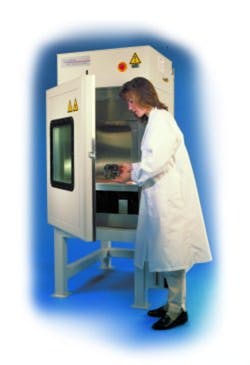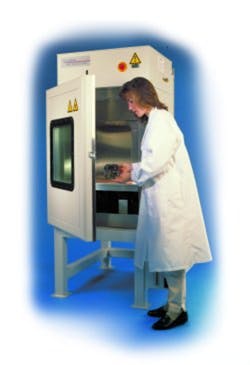Predictably, we found some engineers vibrating the electronic products that you see every day, such as computers and wireless phones. We also uncovered other aspects that were equally interesting—cars, trains, elevators, diesel engines, and petroleum exploration systems.
In our conversations with these users, you will see some commonality in the use of vibration equipment. You also will note that each application has certain unique features.
Torturing Computers
In one interview, we found that Compaq Computer conducts three types of vibration/temperature tests on its computer products. The highly accelerated life test (HALT) is carried to destruction, the highly-accelerated stress audit (HASA) is performed on randomly selected samples from the production line, and highly accelerated stress screening (HASS) is run on every system in the relatively small volume production of mission-critical computers.
Elizabeth Benedetto is a materials engineer at Compaq. She joined the group five years ago and is involved in all phases of product test. “In HALT, we carry the equipment to destruction, running diagnostics continually as we torture it. Tests start at relatively modest vibration levels, then progress in 2.5-grms steps until we have a failure,” Ms. Benedetto noted.
Since she works closely with the design engineers, each failure is analyzed in incredible detail. “After each fix is installed,” she said, “we continue to move through ever-increasing vibration levels until it is obvious that nothing would be gained by further testing.”
Ms. Benedetto learned the test objectives and techniques from her fellow employees when she came on-board and has found tutorial seminars by equipment manufacturers to be quite helpful. What advice does she have for others?
“Even though you always assume that your design is perfect, you’d better thoroughly test it. When you make a component substitution, you believe the new part is as good as the old one or maybe even better. But don’t count on it. Test—it’s worth the effort,” she warned.
Shaking Drilling Equipment
Just a few miles from where Ms. Benedetto evaluates computers, Javier Cortez, project development engineer at Schlumberger, has similar vibration equipment to check electronic instrumentation used in petroleum exploration. “The company uses three-axis vibration to simulate the severe environmental forces the down-hole tubes experience when exploring new drill areas.
“The drills are stuffed full of electronic equipment, and we can’t afford a failure at the bottom of a well. Our vibration testing has destroyed several components that couldn’t take the g forces. Those components would have failed in the hostile environments at the bottom of a 3,000-ft to 5,000-ft well,” Mr. Cortez explained.
“Our test parameters come from 60 or 70 years of company experience in this area. I came here 20 years ago and learned from those who were here already. We have tools being introduced constantly, so we must keep testing and improving our electronics,” he said.
Vibrating Diesels
It’s a long way geographically and technically from computers and oil wells to diesel engines. That’s where we found Harry Bjorkman, a senior reliability engineer at Detroit Diesel. He has been involved in vibration testing of truck and marine engines and related applications since 1984. A big asset in his early days of vibration testing was some training courses taught by Wayne Tustin, the founder of the Equipment Reliability Institute, who stressed an extremely important factor: fixture design.
“We test subassemblies before they go into production. A typical test article is 30 lb to 40 lb although some are a lot heavier. We apply 2,500 lbf or less in the typical case. There’s nothing fancy. We use profiles developed from three-axis accelerometers on working engines,” he said.
Detroit Diesel performs HALT which Mr. Bjorkman classifies as overstress tests. He sees this as a developing technology since he uses service reports from engines in operation to fine-tune the details.
For example, vibration tests at Detroit Diesel uncovered some connector problems on an engine’s electronic control module. “I’m glad we did the vibration tests here. We don’t want some trucker to find an engine problem on a cold, rainy night on a desolate stretch of road. We save our customers untold time and misery by testing thoroughly in our plant,” he continued.
“Computer analysis is valuable, such as generating a power spectral density (PSD) display. However, 90% of our tests are not that fancy, and we are satisfied just to learn the location and magnitude of the resonant points so we can fix the problems,” he explained.
Evaluating Wireless Equipment
Harry McLean, a reliability engineering manager at AT&T Wireless, spent 25 years at Hewlett-Packard and had some valuable vibration test experience with its line of DeskJet printers. At both HP and AT&T, he has seen dramatic results with HALT. His six-degrees-of-freedom shaker system, moving the UUT in the X, Y, Z, roll, pitch, and yaw axes, uncovers several faults not evident in a three-axis system.
“I use random vibration on all axes simultaneously and cover the 2-Hz to 10-kHz spectrum,” he reported. “A typical sequence starts with cold stress, followed by room-temperature operation. Then I go to a high temperature, proceed through a rapid thermal change, and move on to ambient conditions. Next comes the vibration cycle, progressing in 2g to 3g increments. The last test is a combination of vibration and rapid thermal change. We uncover every imaginable problem with this torturous ordeal.”
Vibration testing has uncovered some interesting problems, such as having a crystal fly off a PCB during vibration. “A new mounting style fixed that problem,” he recalled. “Then there were some timing problems that came to light during the temperature cycle. Perhaps the biggest surprise was a firmware problem that could have gone undetected.”
Mr. McLean uses a benchtop spectrum analyzer for equipment validation. “Possibly, I would choose a computer-based analyzer if I were buying an instrument now,” he commented, “but I’m satisfied with what we have. I don’t want to analyze the data to death, and it’s easy to eyeball the analyzer display and learn enough to make intelligent decisions.”
After waiting all these years for someone to write a book covering all the aspects of vibration testing, Mr. McLean decided to do it himself. His book entitled HALT, HASS, and HASA Explained (Accelerated Test Processes) was scheduled to be published in June by Quality Press, part of the American Society for Quality.
Vibrating Elevators
High-technology elevators? Absolutely. Otis has 60,000 employees in several countries providing some of the very latest electronic technology for elevators, escalators, terminal-to-terminal airport shuttles, and other people movers. The largest plant is in Nogales, Mexico, just across the border from Arizona.
Eleazar Estrada, a failure analysis and reliability engineer in Nogales, is responsible for HALT of newly developed control systems. “We also run HASA on a sample of the production output,” he said. “Test limits determined jointly by engineers from the Hartford headquarters and all manufacturing locations generally are 40% to 60% of the destruct conditions determined by HALT.”
Most of Mr. Estrada’s job knowledge came from his fellow engineers, helpful vendors, and hands-on experience. Like his counterparts in other companies, he would like to see a good selection of books on vibration testing to help new engineers coming on the job.
Agitating Trains
Most engineers at Norfolk Southern Railroad drive trains. However, we found one engineer there with 26 years of service who has never operated the controls of a big locomotive.
Robert Blank is director of research and test at Norfolk Southern. “We develop vibration and shock profiles based on over-the-road recordings of ride quality and use the information to evaluate new load-handling devices,” he noted. “We have a research car used for special types of analysis, but most of the data comes from real-world measurements on our 21,800 miles of railroad. Our vibration results are analyzed with LabVIEW software from National Instruments, and we use the results to guide us in designing or procuring new equipment.
“Subassemblies on our 3,500 General Electric and General Motors locomotives are subjected to vibration tests if there is a suspected problem,” Mr. Blank added. “The engines are rugged, but we still have weak spots to be detected and beefed up.”
Quivering Automobiles
A high priority in the automotive industry is the suppression of noise, vibration, and harshness. Manufacturers have established departments dedicated to controlling the vehicle cabin environment to improve rider comfort and eliminate warranty costs for correction of squeaks, rattles, and other noise or excessive vibration. If drivers are happy with their vehicles, they will be repeat customers.
How do these requirements look to a manufacturer of vibration test equipment? We asked Susan Brooksbank, marketing manager at Data Physics.
“Vibration testing for cars involves some unique technology,” she said. “Suppliers’ components must be tested to confirm that they will operate under the expected extreme conditions of use. These may involve single-shaker acceleration with a PSD analysis of random excitation. However, mixing random with sweeping sine tones offers a more accurate simulation of combined road and engine vibration.
“To reproduce the actual vibration caused by different road types,” Ms. Brooksbank continued, “testers record the vibration during a test drive, then use the stored record to control one or more shakers. This simulation method requires algorithms to replicate the actual acceleration at the control point. The controller outputs a time record to drive the shaker, but that record must be compensated so it reaches the control point at the correct time.”
Vibration Can Be Stressful
We asked another test-equipment manufacturer what new applications he sees for vibration equipment. “One of the biggest trends driving the vibration equipment market is the move to production tests incorporating HASS,” said Neill Doertenbach, technical sales manager at QualMark. This technology is growing rapidly. Automotive, communications, and consumer product companies are using vibration as part of their production screening.
The Bottom Line
In shaker applications, some users stick to the absolute basics. If three-axis vibration works, use it. If you can eyeball the spectrum and identify trouble spots, do it.
On the other hand, some rather sophisticated technology is available when you need special performance. Six-degrees-of-freedom systems may be necessary to uncover subtle problems in complex hardware, and a computer with powerful software could make your analysis run faster and give you more accurate results.
We have seen how secrets of the trade are passed along in some labs, while other labs are groping for hints on how to test adequately and then analyze the data. And, we have learned that a new book is available on the subjects of HALT, HASS, and HASA.
Published by EE-Evaluation Engineering
All contents © 2000 Nelson Publishing Inc.
No reprint, distribution, or reuse in any medium is permitted
without the express written consent of the publisher.
July 2000

